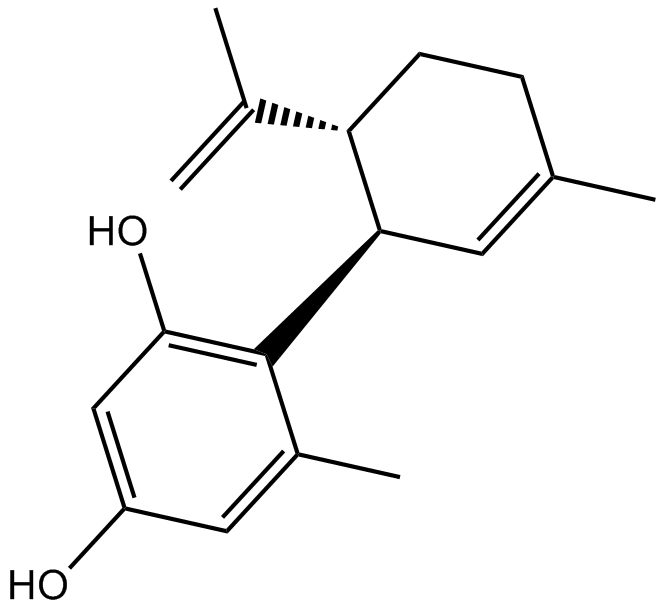O-1602 (Synonyms: Abn-CBDO, Abnormal Cannabidiorcin, Abnormal Cannabidiorcinol, Abnormal Cannabiorcodiol) |
| Katalog-Nr.GC13513 |
GPR55 cannabinoid receptor agonist
Products are for research use only. Not for human use. We do not sell to patients.

Cas No.: 317321-41-8
Sample solution is provided at 25 µL, 10mM.
O-1602 is an agonist of GPR55 (EC50 = 13 nM in a GTPγS binding assay) and a derivative of the GPR55 agonist abnormal cannabidiol.[1] It is selective for GPR55 over cannabinoid (CB) receptor 1 (CB1) and CB2 (EC50s = >30 µM for both in GTPγS binding assays). O-1602 (50 µM) reduces growth of Mz-ChA-1, HuCCT-1, CC-LP-1, and SG231 cholangiocarcinoma cells and reduces tumor growth in a Mz-ChA-1 mouse xenograft model when administered at a dose of 10 mg/kg per day.[2] O-1602 increases calcium mobilization and lipogenesis in 3T3-L1 adipocytes in a concentration-dependent manner and increases food intake and fat mass in rats; however, this effect was also observed in mice lacking GPR55.[3] O-1602 reduces movement-induced firing of nociceptive C fibers in a rat model of inflammatory joint pain.[4] It also decreases IL-6 and TNF-α levels and myeloperoxidase activities in the plasma, lungs, and pancreas in a mouse model of acute pancreatitis.[5]
Reference:
[1]. Ryberg, E., Larsson, N., Sjögren, S., et al. The orphan receptor GPR55 is a novel cannabinoid receptor. Br. J. Pharmacol. 152(7), 1092-1101 (2007).
[2]. Huang, L., Ramirez, J.C., Frampton, G.A., et al. Anandamide exerts its antiproliferative actions on cholangiocarcinoma by activation of the GPR55 receptor. Lab Invest. 91(7), 1007-1017 (2011).
[3]. Díaz-Arteaga, A., Vázquez, M.J., Vazquez-Martínez, R., et al. The atypical cannabinoid O-1602 stimulates food intake and adiposity in rats. Diabetes Obes. Metab. 14(3), 234-243 (2012).
[4]. Schuelert, N., and Mcdougall, J.J. The abnormal cannabidiol analogue O-1602 reduces nociception in a rat model of acute arthritis via the putative cannabinoid receptor GPR55. Nuerosci. Lett. 500(1), 72-76 (2011).
[5]. Li, K., Feng, J.-Y., Li, Y.-Y., et al. Anti-inflammatory role of cannabidiol and O-1602 in cerulein-induced acute pancreatitis in mice. Pancreas 42(1), 123-129 (2013).
Average Rating: 5 (Based on Reviews and 14 reference(s) in Google Scholar.)
GLPBIO products are for RESEARCH USE ONLY. Please make sure your review or question is research based.
Required fields are marked with *




















